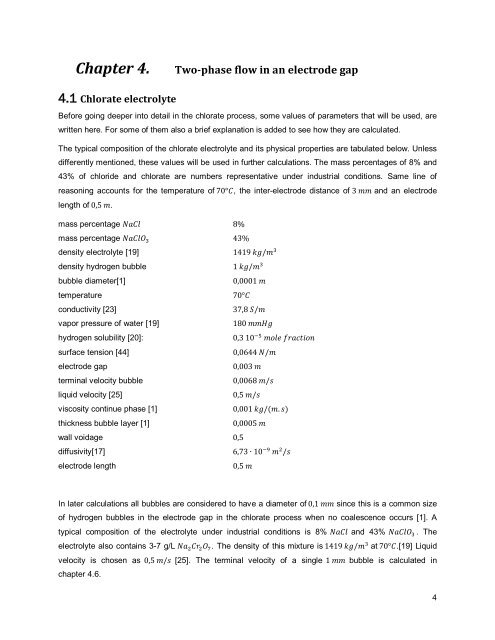A bubble curtain model applied in chlorate electrolysis
A bubble curtain model applied in chlorate electrolysis
A bubble curtain model applied in chlorate electrolysis
Create successful ePaper yourself
Turn your PDF publications into a flip-book with our unique Google optimized e-Paper software.
Chapter 4.<br />
Two-phase flow <strong>in</strong> an electrode gap<br />
4.1 Chlorate electrolyte<br />
Before go<strong>in</strong>g deeper <strong>in</strong>to detail <strong>in</strong> the <strong>chlorate</strong> process, some values of parameters that will be used, are<br />
written here. For some of them also a brief explanation is added to see how they are calculated.<br />
The typical composition of the <strong>chlorate</strong> electrolyte and its physical properties are tabulated below. Unless<br />
differently mentioned, these values will be used <strong>in</strong> further calculations. The mass percentages of 8% and<br />
43% of chloride and <strong>chlorate</strong> are numbers representative under <strong>in</strong>dustrial conditions. Same l<strong>in</strong>e of<br />
reason<strong>in</strong>g accounts for the temperature of 70°C, the <strong>in</strong>ter-electrode distance of 3 mm and an electrode<br />
length of 0,5 m.<br />
mass percentage NaCl 8%<br />
mass percentage NaClO 3 43%<br />
density electrolyte [19] 1419 kg/m 3<br />
density hydrogen <strong>bubble</strong> 1 kg/m 3<br />
<strong>bubble</strong> diameter [1] 0,0001 m<br />
temperature 70°C<br />
conductivity [23] 37,8 S/m<br />
vapor pressure of water [19] 180 mmHg<br />
hydrogen solubility [20]: 0,3 10 −5 mole fraction<br />
surface tension [44] 0,0644 N/m<br />
electrode gap 0,003 m<br />
term<strong>in</strong>al velocity <strong>bubble</strong> 0,0068 m/s<br />
liquid velocity [25] 0,5 m/s<br />
viscosity cont<strong>in</strong>ue phase [1] 0,001 kg/(m. s)<br />
thickness <strong>bubble</strong> layer [1] 0,0005 m<br />
wall voidage 0,5<br />
diffusivity[17] 6,73 ∙ 10 −9 m 2 /s<br />
electrode length<br />
0,5 m<br />
In later calculations all <strong>bubble</strong>s are considered to have a diameter of 0,1 mm s<strong>in</strong>ce this is a common size<br />
of hydrogen <strong>bubble</strong>s <strong>in</strong> the electrode gap <strong>in</strong> the <strong>chlorate</strong> process when no coalescence occurs [1]. A<br />
typical composition of the electrolyte under <strong>in</strong>dustrial conditions is 8% NaCl and 43% NaClO 3 . The<br />
electrolyte also conta<strong>in</strong>s 3-7 g/L Na 2 Cr 2 O 7 . The density of this mixture is 1419 kg/m 3 at 70°C.[19] Liquid<br />
velocity is chosen as 0,5 m/s [25]. The term<strong>in</strong>al velocity of a s<strong>in</strong>gle 1 mm <strong>bubble</strong> is calculated <strong>in</strong><br />
chapter 4.6.<br />
4















